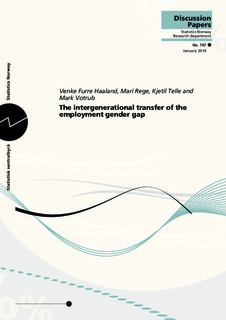The intergenerational transfer of the employment gender gap
| dc.contributor.author | Haaland, Venke Furre | |
| dc.contributor.author | Rege, Mari | |
| dc.contributor.author | Telle, Kjetil | |
| dc.contributor.author | Votruba, Mark | |
| dc.coverage.spatial | Norway | nb_NO |
| dc.date.accessioned | 2019-11-12T09:23:57Z | |
| dc.date.available | 2019-11-12T09:23:57Z | |
| dc.date.issued | 2014-01 | |
| dc.identifier.issn | 0809-733X | |
| dc.identifier.uri | http://hdl.handle.net/11250/2627859 | |
| dc.description.abstract | Despite well-documented convergence during the later years of the 20th century, labor market attachment remains markedly higher for men than for women. The current paper employs rich longitudinal registry data to investigate the intergenerational transfer of the gender gap in employment. We explore the extent that family- and community-level characteristics, measured in childhood, differentially predict employment for adult Norwegian men and women. Drawing on theories pertaining to the importance of information, skills and gender norms transfer, our empirical analysis demonstrates that a parsimonious set of family- and community-level characteristics can explain a substantial part of the gender gap. These results suggest that female employment continues to be influenced by the intergenerational transfer of beliefs and expectations about family and work. | nb_NO |
| dc.description.sponsorship | Norwegian Research Council (OF-10018) | nb_NO |
| dc.language.iso | eng | nb_NO |
| dc.publisher | Statistisk sentralbyrå | nb_NO |
| dc.relation.ispartofseries | Discussion papers;767 | |
| dc.subject | JEL classification: J16 | nb_NO |
| dc.subject | JEL classification: J21 | nb_NO |
| dc.subject | JEL classification: D13 | nb_NO |
| dc.subject | JEL classification: N30 | nb_NO |
| dc.subject | JEL classification: Z13 | nb_NO |
| dc.title | The intergenerational transfer of the employment gender gap | nb_NO |
| dc.type | Working paper | nb_NO |
| dc.description.version | publishedVersion | nb_NO |
| dc.subject.nsi | VDP::Matematikk og Naturvitenskap: 400::Matematikk: 410::Statistikk: 412 | nb_NO |
| dc.source.pagenumber | 52 | nb_NO |
Tilhørende fil(er)
Denne innførselen finnes i følgende samling(er)
-
Discussion Papers [1004]
